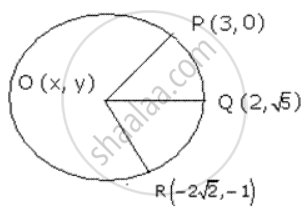Advertisements
Advertisements
प्रश्न
Find the coordinate of O , the centre of a circle passing through P (3 , 0), Q (2 , `sqrt 5`) and R (`-2 sqrt 2` , -1). Also find its radius.
उत्तर

Let O (x, y) be the centre of the circle
OP = OQ (radii of same circle)
⇒ OP2 = OQ2
`(sqrt (("x" - 3)^2 + ("y" - 0)^2))^2 = (sqrt (("x" - 2)^2 + ("y" - sqrt 5)^2))^2`
⇒ x2 + 9 - 6x + y2 = x2 + 4 - 4x + y2 + 5 - 2`sqrt 5`y
⇒ - 2x + 2`sqrt 5`y = 0
⇒ - x + `sqrt 5` y = 0 .........(1)
Similarly , OQ = OR
⇒ OQ2 = OR2
⇒ (x - 2)2 + (y - `sqrt 5`)2 = (x + 2 `sqrt 2`)2 + (y + 1)2
⇒ x2 + 4 - 4x + y2 + 5 - 2`sqrt 5` y = x2 + 8 + `4 sqrt 2` + y2 + 1 + 2y
⇒ - 4 x - `4sqrt 2 "x" - 2 sqrt 5 "y" = 0`
⇒ - 2x - 2`sqrt 2 "x"` - `sqrt 5 "y"` - y = 0 .......(2)
Putting x = `sqrt 5` y from (1) and (2)
`-2 sqrt 5 "y" - 2 sqrt 10 "y" - sqrt 5 "y" - "y" = 0`
`(-3sqrt 5 - 2sqrt 10 - 1) "y" = 0`
y = 0
from (1)
x = `sqrt 5 (0) = 0`
⇒ x = 0
Thus , coordinates of O are (0 , 0).
Radius = `sqrt ((0-3)^2 + (0 - 0)^2) = sqrt 9` = 3 units
APPEARS IN
संबंधित प्रश्न
The x-coordinate of a point P is twice its y-coordinate. If P is equidistant from Q(2, –5) and R(–3, 6), find the coordinates of P.
If A(5, 2), B(2, −2) and C(−2, t) are the vertices of a right angled triangle with ∠B = 90°, then find the value of t.
If the point P(2, 2) is equidistant from the points A(−2, k) and B(−2k, −3), find k. Also find the length of AP.
The length of a line segment is of 10 units and the coordinates of one end-point are (2, -3). If the abscissa of the other end is 10, find the ordinate of the other end.
Find the distances between the following point.
A(a, 0), B(0, a)
A point P (2, -1) is equidistant from the points (a, 7) and (-3, a). Find a.
The length of line PQ is 10 units and the co-ordinates of P are (2, -3); calculate the co-ordinates of point Q, if its abscissa is 10.
Seg OA is the radius of a circle with centre O. The coordinates of point A is (0, 2) then decide whether the point B(1, 2) is on the circle?
A circle has its centre at the origin and a point P(5, 0) lies on it. The point Q(6, 8) lies outside the circle.
What type of a quadrilateral do the points A(2, –2), B(7, 3), C(11, –1) and D(6, –6) taken in that order, form?
